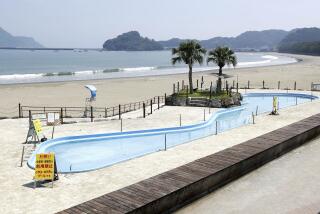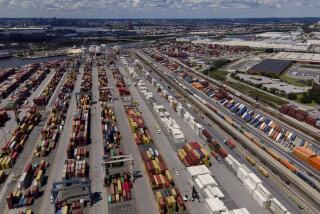Kobe Quake Has Firms Scrambling for a Port : Shipping: Companies are working around the clock to find alternative ways to get their goods to market.
KOBE, Japan — Nihon Shokubai is a key supplier to the disposable-diaper makers of the world. In a city east of here, it produces one-fifth of the super-absorbent chemicals used in the diapers. But ever since the earthquake crippled this city’s major ports and key freeway arteries, exports have ground to a halt.
The chemical maker has had to settle for an onerous solution. It will truck the chemicals west to the small port of Tamashima, then ship the goods in small vessels that ply the inland sea. The ships will unload the cargo at Osaka, where it will be loaded for export aboard large container vessels.
A Nihon Shokubai official says the company must scramble to get the new route established before customers start running out of inventories in a couple of months.
“The problems have just begun,” says Kenji Oyama, a spokesman for Nihon Shokubai. “We don’t know how much worse it’s going to get. The confusion will continue for some time.”
With experts estimating months and even years before Kobe’s port and major arteries are fully restored, Japanese companies are working around the clock to find alternative means to get their products to market.
Japanese ports like Tamashima, long left largely unused as the world has moved toward the use of larger ports with giant cranes for unloading containers, are suddenly finding themselves back in demand.
“Until now the port was pretty quiet,” says Tomoyuki Mizuta, an official working with the port. “There were days when there was no traffic.” Now, he says he is getting calls from all over Japan.
For companies located on the east side of the fissure that cracked the nation’s transportation network in half, matters are simpler. Osaka, Nagoya and Yokohama are all possible alternatives.
Kawasaki Kisen, a major shipper, for example, is diverting its ships from Kobe to the port of Osaka, where extra capacity to handle the expected demand is being added.
But even when that construction is done, Osaka will be able to handle only a small portion of the rerouted traffic.
“It isn’t just a question of bringing the goods in. You have to arrange for storage and delivery,” says Kazuyuki Oda, an official at Kawasaki Kisen. He said Osaka isn’t designed to handle the required volumes.
To avoid congestion at ports like Osaka, a growing number of companies are shipping their products in small boats to Pusan, on the southern tip of South Korea, for transfer to large container ships. The Korean port, which was operating at about 65% of capacity before the earthquake, said it is now booked up.
All this means that shipping times are lengthening and costs are climbing. Truck drivers for companies like Matsushita are winding their way through distant northern routes to avoid congestion in the Kobe area.
Companies elsewhere in Southeast Asia have already begun to complain that some of their factories will have to shut down if they can’t get more timely delivery of key Japanese parts.
An auto assembly plant in Indonesia, for example, says it has inventory for only two or three weeks of production and will have to close down its factory unless shipment of components from Daihatsu Motor are resumed.
The problem works in both directions. Matsushita’s air-conditioner production, for example, depends on parts from its Malaysia subsidiary that may now have trouble getting into Japan.
Minoru Tada, manager of equities at the Osaka office of Nomura Securities, Japan’s largest brokerage, is among the optimists. He notes that much of the Kobe port’s facilities consist of floating docks that can be built in the various shipyards in Japan that have huge overcapacity.
Experts say limited trade may be restored in as short a time as four months, but most believe it will take two years to reach pre-earthquake levels. Kobe city officials estimate a cost of $10 billion and three years to restore the port to full operation.
RELATED STORIES: A8, B1, B3
More to Read
Sign up for Essential California
The most important California stories and recommendations in your inbox every morning.
You may occasionally receive promotional content from the Los Angeles Times.










